Thangka Painting - The Encyclopedia of Tibetan Culture
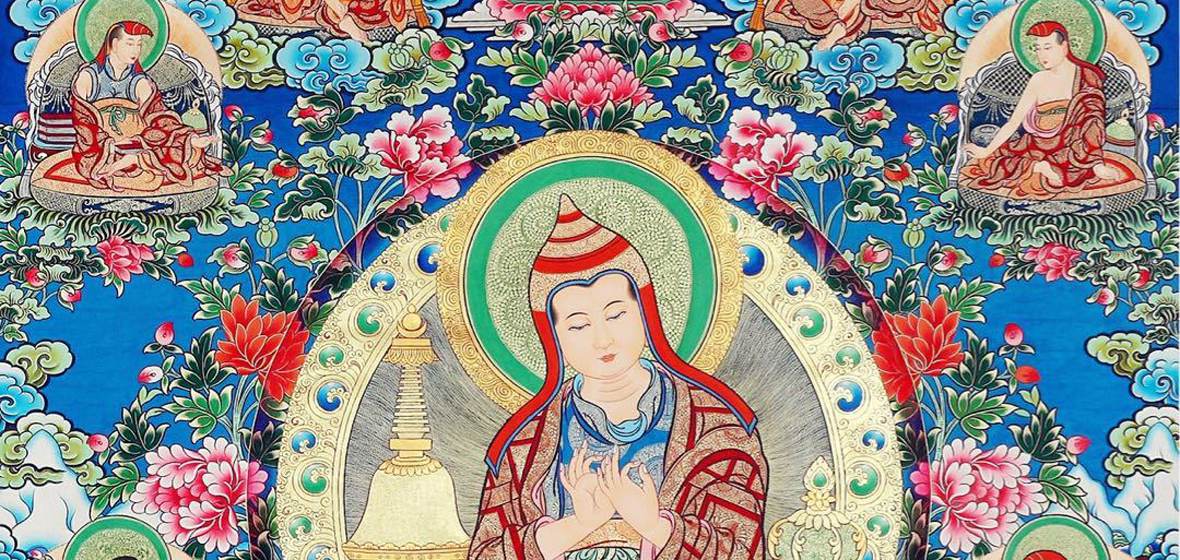
A Thangka painting is a Tibetan Buddhist artwork on cotton with silk appliqué depicting deities, religious figures, or historical events. Each Thangka is hung in a monastery or a family altar and carried by Buddhist monks in ceremonial processions. Thangkas are used to teach students and monks about the aspects of Buddha, describe important historical events, and illustrate myths associated with important deities. It is a valuable meditation tool and offers a manifestation of the divine that is both visually and mentally stimulating.
Thang means "flat" in Tibetan and ka means “void to be filled”; thus, Thangka paintings are created to show what is painted in frescoes. Devotional images act as a focus during rituals and ceremonies and are often used as media through which prayers are offered and particular requests made. During the Shoton Festival, the Potala Palace and monasteries in Lhasa, and the Ta’er Monastery in Qinghai hold grand events to unfold their huge Thangkas.
Hope you enjoy this article. Tashi Delek! – meaning “Good Luck and Happiness!” in the Tibetan language.
History of Tibetan Thangka Art
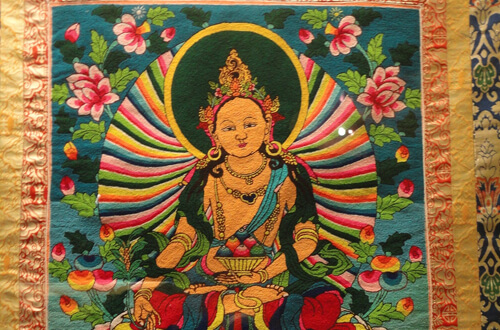
Some scholars believe Tibetan Thangka painting is a Nepalese art form exported to Tibet. It was bring to Tibet by Princess Bhrikuti of Nepal, a daughter of King Lichchavi and a wife of Songtsen Gampo (ruled Tibet from 614 to 650 CE). Others claim that Han Chinese painting had a profound influence on Tibetan painting in general. According to the book Sakyamuni Crystal Mirror by the Fifth Dalai Lama Ngawang Lobsang Gyatso (1617-1682), his Holiness Songtsen Gampo painted a Palden Lhamo (Auspicious goddess) with a nose bleed. It was thought to be the beginning of Thangka painting.
From the 14th century onwards, Chinese painting had a significant influence on Tibetan art and by the 18th century, Tibetan painting echoed and incorporated many Chinese elements of detail and design. The blue-green mode of painting was evident in Thangkas painted after the 15th century.
Because they could be easily rolled and transported, Thangkas became increasingly popular among the nomadic monks of medieval Tibet who travelled extensively between rural communities and regional monasteries to provide religious instruction. They are still used today for teaching and are a familiar sight in both Nepal and Tibet, becoming increasingly common in the West along with the spread of eastern spirituality.
Types of Thangkas
Thangka art is closely associated with the society, history, culture, art, religion, and geographical environment of Tibetans.
From their colors, Thangkas can be classified as Black Thangka, Red Thangka, Blue Thangka, Golden Thangka, and Silver Thangka.
In terms of subject, Thangkas can be classified as Dethang, Xiethang, Manthang, Zithang, and Zongthang. Dethang and Xiethang refer to the Thangkas that are all about Buddhist stories. Manthang are devoted to Tibetan medicine. Zithang are devoted to Tibetan science like astronomy and the calendar. The paintings with the stories of epic King Gesar as the motif are known as Zongthang.
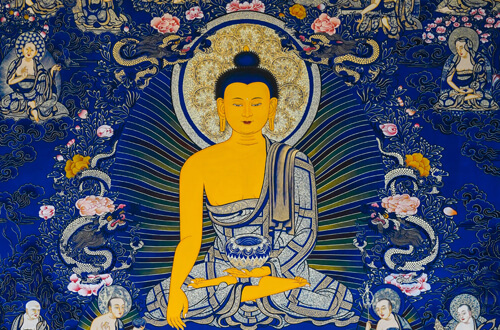
In terms of painting techniques, Thangkas can be classified as Cuithang, Nathang, Sethang, and Cethang. While Cuithang refers to color paintings, Nathang are ink paintings. Because Nathang is easy to paint, the earlier paintings of King Gesar were mostly Nathang. Nathang is also widely used to paint the guardian deities of Tantra of Tibetan Buddhism, in order to give it a mysterious touch. Sethang, painted with gold powder, are mainly dedicated to the images of Buddhas and masters, so as to highlight their holiness and gravity. “Ce” in Tibetan means "red”, and Cethang paintings are painted with cardinal red pigment, so as to bring about strong visual impact. Cethang paintings are mostly devoted to 1,000 Tara, 1,000 longevity Buddhas, or other Buddhas in groups.
In terms of painting styles, there are three schools of Thangka, the Gama Gazi School, Manthang School, and Chinze School.
The Gama Gazi School was founded by the 8th Karmapa Mikyö Dorje (1507-1554). He was the eighth Karmapa, head of the Karma Kagyu lineage of Tibetan Buddhism. He is arguably the most famous of the Karmapas. An outstanding master in all the arts and sciences, he wrote widely on a great many subjects. The Gama Gazi School is the most dominant Thangka school of painting in the Kham region in the eastern part of Tibet. They incorporated Chinese painting style into the Indian painting style.
The founder of the Manthang School was Mianla Dhondup Gyatso, who was born in Loza Miantang (present-day Shannan region in southern Lhasa), from which the school got its name. Painters of this school pay attention to the use of painting lines; their lines are neat and smooth. Their color is also lively and bright. From the end of the 17th century to the beginning of the 18th century, the Miantang School entered its heyday, and excellent painters emerged one after another. The murals of the three major monasteries of the Potala Palace, Norbulingka, Lhasa Drepung, Sera, and Ganden remain, and the Thangkas were painted by the painters of the Miantang School.
The founder of the Chinze School was Chenzi Chemo from today's Gongkar County of Lhoka Prefecture. The composition of the Chinze School maintains the characteristics of the large main statue in the Indo-Nepalese painting tradition, with a prominent focus and an orderly arrangement of the surrounding small statues. However, in the expression of landscapes, the expressive program of Han painting has begun to be integrated. It is said that the murals of Dorje Drak Monastery in Shannan were painted by Chinze Chemo.
Content of Tibetan Thangka Art
The content of Thangkas varies quite a bit. They usually contain portraits of bodhisattvas, giant mandalas, and Tibetan Buddhist gods, images of Buddhas, and Jataka stories of the Buddha, but may also cover or touch on historical events, biographies, religious ideas, scenery, everyday life, folklore, myths, Tibetan astrology, and medicine. Typically, they depict Tibetan gods and other religious iconography such as Padmasambhava and White Tara and Green Tara, and the circle of life with people reclining in heaven and roasting in hell. The setting, the background, architectural elements, and secondary figures are all executed with special aims and symbolic meaning.
Most Popular Motifs and their Meanings in Thangka Painting:
The most popular motifs are eight auspicious signs or symbols. They are considered a teaching tool, which point to the qualities of enlightenment.
1. The Lotus Flower
The lotus flower is a symbol of purity and enlightenment. It symbolizes the Buddha's purity and detachment from worldly affairs, as well as his awakening. The lotus flower, which has its roots in the mud, deep at the bottom of the pond, nonetheless grows and is able to float immaculately and in sheer purity above the muddy waters. So too, can one’s body, speech, and mind learn to be free of desire and attachments. The bloom of a Buddhist lotus has 4, 8, 16, 24, 32, 61, 100 or 1,000 petals and these same numbers can correspond to the body’s chakras or energy centers.
2. The Wheel of Law (The Dharmachakra)
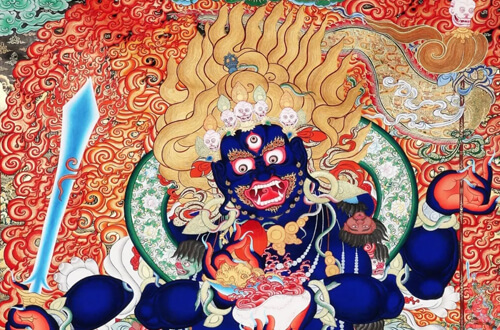
The wheel symbolizes the Buddha's first sermon in Sarnath, where he taught the Four Noble Truths and the Eightfold Path. The eight spokes of the wheel represent these paths. It represents the auspiciousness of the precious teaching and realization of Buddha’s doctrine. It is symbolic of the continuation or turning of the wheel, of the Dharma teachings, across all realms and times. As such, all beings are able to continue to experience the liberation it offers.
3. White Conch shell
The conch shell symbolizes the Buddha’s fearlessness in teaching the truth of the Dharma. It also doubles as a symbol of power and as a symbol of protection. It awakens disciples from their own deep slumber of ignorance and instead, encourages them to not only seek to accomplish their own welfare, but also to strive to realize the welfare of others.
4. The Endless Knot
The knot illustrates how everything in the world is connected, and to attain enlightenment, one must practically apply gained wisdom and knowledge into every aspect of their life. The knot also represents the endless cycle of birth, death, and rebirth.
5. The Pair of Golden Fish
The symbol of the pair of golden fish is used to symbolize the auspiciousness of all conscious beings in a state of complete fearlessness. In the same manner in which fish swim freely through the ocean, so too should all living beings live spontaneously and freely as they migrate from one place to another, without fear of drowning in samsara – the perpetual cycle of rebirth, existence, and death.
6. The Parasol
The symbol of the jeweled or precious parasol represents the protection of all beings from harmful forces, illnesses, disease, and the obstacles confronted during this life.
7. The Victory Banner
The banner or dhvaja, represents Buddha’s victory over all hindrances on the path to achieving enlightenment. The victory banner is also used to symbolize the victory over negativity, challenges, and hurdles confronted by each individual and the activities of one’s own mind, body, and speech in overcoming these.
8. The Treasure Vase
The vase symbol represents the wealth of Buddha’s teachings. It is always overflowing with wealth and sometimes even has lotus flowers painted on it. As such, the treasure vase is also symbolic of longevity, wisdom, and all the benefits offered in this world, as well as liberation. It further symbolizes wealth, prosperity, long life, and health. Due to its representation, the vase or wisdom urn is also often used in many initiations and empowerments.
Great Thangkas
The Longest Thangka
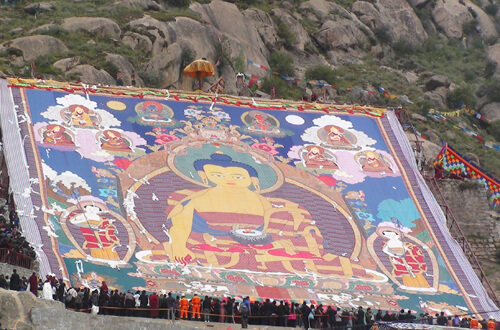
With a total length of 618 meters and a width of 2.5 meters, the whole scroll is more than 1,500 square meters and weighs 1.5 tons. The entire scroll depicts more than 183,000 figures, and more than 3,000 embroidery patterns are embellished on both sides. The painting is one of the longest Thangkas in the world. More than 400 Tibetan artists spent almost 30 years finishing the masterpiece. The Thangka shows the entire Tibetan history, the history of Tibetan Buddhism, and famous Buddhist monks, temples, and events. It also depicts the creation of the world, astronomy, technology, science, medicine, architecture, linguistics, and poetry. It is housed in the Qinghai Tibetan Culture Museum in Xining in Qinghai province.
The Most Expensive Thangka
The “Imperial Embroidered Silk Thangka” (painted 1402-24) is the most expensive Thangka painting ever sold at auction. It was sold for US$45 million at Christie’s in Hong Kong in November 2014. Its size is bigger than a king-size bed, it was entirely worked with silk embroidery, and it depicts Raktayamari, ‘The Red Killer of Death’, a meditational deity in Mahayana Buddhism. It was made on command of the Ming dynasty Yongle Emperor (who also ordered to build the Forbidden City in Beijing). It is housed in the Long Museum in Shanghai.
The Earliest Extant Thangka
The earliest extant Thangka is Green Tara Thangka housed in Reting monastery in Linzhou county, northern Lhasa, and depicts the enlightened Buddha, and compassionate goddess Tara, sitting on a lotus in her mountain paradise. Tara navigates men and women across the negative emotions that prevent them from attaining supreme peace and happiness, or "nirvana." It was believed to be painted around 1080 CE.

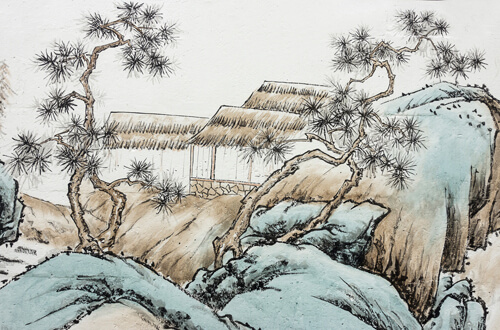 Chinese Painting
Chinese Painting 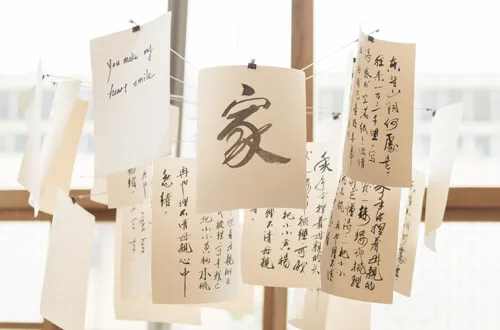 Chinese Calligraphy
Chinese Calligraphy 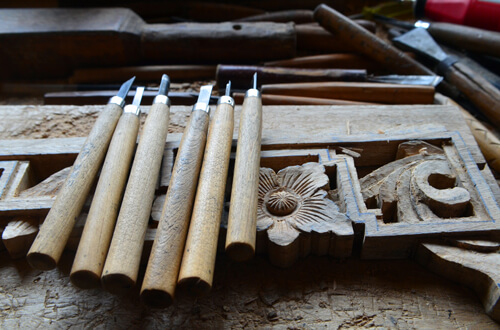 Chinese Woodcarving Art
Chinese Woodcarving Art 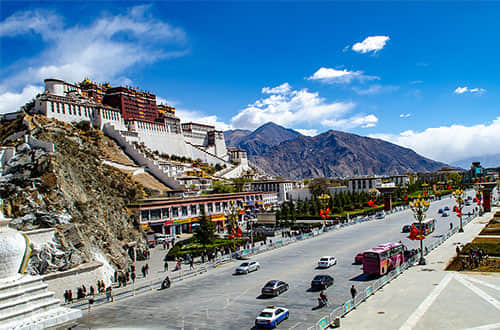 Tibet Travel Guide
Tibet Travel Guide